A Retrospective of Shogun: Total War
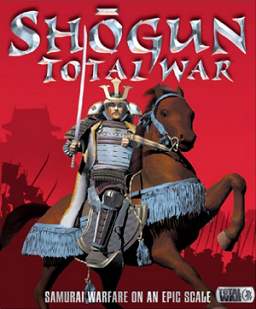 “When you have attained the way of strategy there will be nothing that you cannot understand. You will see the way in everything.” – Miyamoto Musashi
“When you have attained the way of strategy there will be nothing that you cannot understand. You will see the way in everything.” – Miyamoto Musashi
By Patrick S. Baker
Small Beginnings
In November 2023, Ranker.com named the Total War game series: “The Greatest Strategy Game Franchises of All Time”, even better than the much-vaunted Civilization franchise. Hard to believe it all started as an idea for a “B-Title” Real-Time Strategy (RTS) game.
In 1997, Command & Control (C&C) dominated the RTS game market. A whole slew of cheap knockoffs had been released and were doing brisk sales, one “pile of crap” C&C-clone called Krush, Kill ‘N’ Destroy had done some 600,000 units in sales.
Enter Tim Ansell, founder, owner and Chief Executive Officer of The Creative Assembly game company. Creative Assembly (CA) had been grinding away, porting sports games for gaming giant Electronic Arts (EA) and selling about 100,000 units per game. Ansell heard about the success of Krush, Kill ‘N’ Destroy and decided Creative Assembly would to do its own “upmarket clone” of C&C.
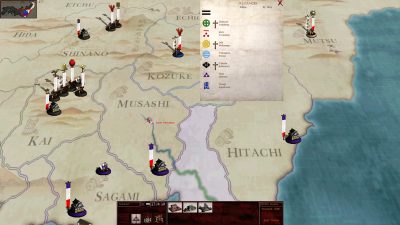
Ansell turned to Mike Simpson, CA’s senior producer and gave him orders to do a quick, inexpensive “B-title game.” However, over the three years of development the game’s concept shifted from a cheap C&C knockoff into a Turn-Based Strategy/Real-Time Tactical (TBS/RTT) hybrid game.
Further, the game changed from having a simple top-down 2D view to having 3D graphics for the battles. Also, a demand for historical realism came to the front for the design. Enter military historian Stephen Turnbull, who specialized in the “samurai period of Japan”, the good professor came on to advised the CA’s design team regarding the historical background in the game.
In short, the game that would become Shogun: Total War went from being simply a cheap knock-off of C&C to an engaging, challenging and ground breaking start of a great franchise, kind of like rock soup.
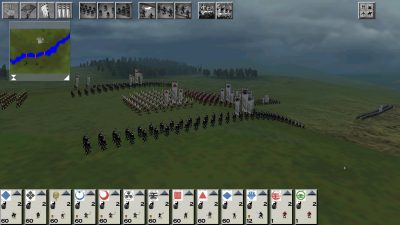 Two Levels of Play
Two Levels of Play
Shogun came across as something new and different from the start with its setting during the Sengoku Jidai or “Warring States Period” of Japanese history, circa 1467 to 1568 of the Common Era. While an emperor officially ruled, he was largely sidelined, with the real power resting with the shogun, or military dictator; officially the Sei-i Taishōgun “Commander-in-Chief of the Expeditionary Force Against the Barbarians”.
During Sengoku Jidai various clan chiefs, called daimyos, struggled to increase the power of their clans and maybe even become shogun, using diplomacy, espionage, assassination and open warfare. To further complicate the situation Portuguese traders and missionaries arrived, introducing tempura cooking, gunpowder weapons, and Christianity to the Land of the Rising Sun.
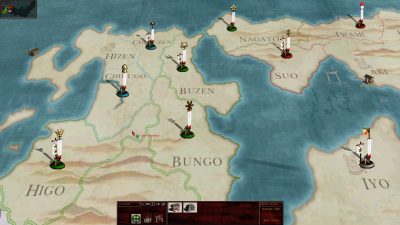
In the game, the player takes the role of one of these daimyos with the goal of becoming shogun. The player may choose from one of seven historical clans. This choice determines the player’s geographic starting position and some different starting advantages as well. For example, the Takeda Clan gets bonuses to their cavalry, the Imagawa get a bonus to their spies, and so on.
Shogun’s game play is divided in to a turn-based strategy mode and real-time tactical battles.
On the “Risk-like” campaign map the player maneuvers his military units and agents. The agents are emissaries that act as diplomatic envoys, ninjas and shinobis which are spies and assassins. Lastly are the Geisha who can both stop assassins from infiltrating your castle and as act as assassins themselves. They also cannot be killed in a failed assassination attempt which makes them very powerful.
As daimyo, you also manage the provinces by building buildings, such as various kinds of castles, ports, dojos, etc. Some of these buildings allow for the training of soldiers and agents. Other building increase trade or access resources which provide koku (money). Some provinces have special resources that can be exploited. Further, the clan chief must maintain public order in his territories.
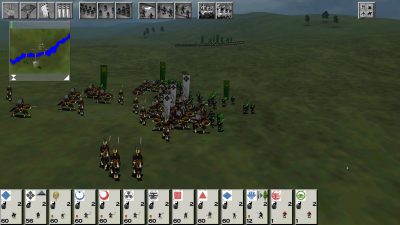
A daimyo can convert to Christianity, giving him access to Portuguese trade goods, especially guns. But this causes diplomatic issues and public order troubles.
All that being said, the real focus of Shogun is the RTT level. While the battles can involve some 5,000 individual soldiers per side engaged in single battle, they do not devolve into a simple numbers game, slugging match, or barroom brawl. Rather the player must deploy wisely, maneuver smartly and apply good tactics to win.
Shogun was the first RTT game to employ terrain advantages, active weather effects, troop morale and fatigue in to the battle programming. Further, the combat system was based on Sun Tzu’s The Art Of War. The Artificial Intelligence (AI) punishes foolish moves. The player finds this out the first time they send their cavalry uphill against well-ordered spearmen. Or when their larger force is fixed at the front and attacked on the unguard flanks by a smaller force.
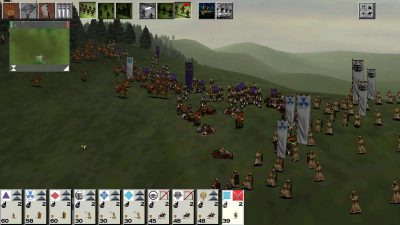 Release and Reception
Release and Reception
Shogun was revealed to the public at 1998’s European Computer Trade Show trade show. Ansell later said that the game’s “public debut went down a storm” and the CA team was “confident it would be successful” and successful it was.
Shogun was released on 12 June 2000 in North America and just four days later in Europe. Reviews were very favorable. Metacritic has the original release at an aggregated 84%, with 22 positive reviews and 2 mixed. One reviewer said: “If Sun Tzu were alive today, he’d be loving this game.”
Another said: “…a perfect melding of strategic and tactical game play.” In general, the replayability, unique setting and depth of the two levels of play were praised; as was the AI and seamlessness of the action.
On the downside, many reviewers disliked the User Interface (UI), calling it “clunky” and “difficult”. Other reviewers called the strategic level “monotonous.” Some lamented the limited diplomacy. Still, these things were, at most, minor complaints about an otherwise great game. Further, some programming bugs were reported, which CA promptly fixed.
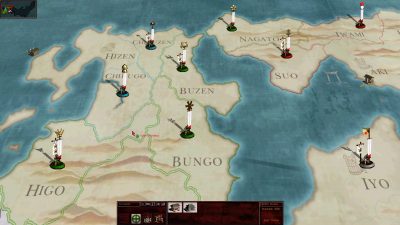
In 2001, Shogun was more bridesmaid than bride when it came to awards for games released in 2000. The game was a contender for CNET Gamecenter’s “Best Real-Time Strategy Game” award, but that went to Sacrifice instead. Computer Gaming World nominated Shogun as the “Best Wargame of 2000”, saying the game was “a dream come true for fans of medieval Japanese warfare”, but it lost to Combat Mission: Beyond Overlord.
Also, Computer Games Magazine nominated the game for their 2000 “Strategy Game of the Year” award, but it lost there as well. Shogun was also nominated for a 2000 British Academy of Film and Television Arts (BAFTA) Interactive Entertainment Award, in the “Games – PC” category.
Shogun did win the award for “Best Strategy Game” at GameSpot’s Best and Worst of 2000 Awards.
Unsurprisingly, Shogun sold well. The game retailed at least 200,000 units in Europe by 2009 and between 100,000 and 390,000 units by 2006 in North America. Ansell said later that Shogun “didn’t set the world alight in terms of sales, but it was still up there with the big guns.”
Summing up, Shogun: Total War established “a strong foundation” for one of the most popular strategy game franchises ever. Further, and maybe above all, Shogun proved that the hybrid approach of blending both Turn Based Strategy and Real Time Tactical levels into one game could be successful both critically and commercially.
Patrick S. Baker is a former US Army Field Artillery officer and retired Department of Defense employee. He has degrees in History, Political Science, and Education. He has been writing history, game reviews, and science-fiction professionally since 2013. Some of his other work can be found at Sirius Science Fiction, Sci-Phi Journal, Armchair General, and Historynet.com.
British Academy of Film and Television Arts (BAFTA) “InteractiveGames – PC in 2000”
CNET Gamecenter’s (December 2001) “Best Real-Time Strategy Game”
Computer Games Magazine (February 2001) “Computer Games Magazine announces nominees for annual best in computer gaming awards”
Computer Gaming World (April 2001) Game of the Year Award
EatSleepGameRepeat.com (2023) Shogun: Total War – A Retrospective Journey Through Time
Gamespot.com (June 2000) “Shogun: Total War Review”
Gamespot.com (February 2001) “Best and Worst of 2000”
IMDB.Com Stephen Turnbull: Biography
MetaCritic PC Critic Reviews Shogun: Total War
Nextgen (July 2000). “Shogun: Total War”.
PC Zone (2004) “Games That Changed The World: Shogun: Total War”
Ranker.com (2023) The Greatest Strategy Game Franchises Of All Time
Rock, Paper, Shotgun (2007) The Making of: Shogun: Total War
StrategyFrontGaming.com (2020) The First Total War: Shogun Total War Retrospective
